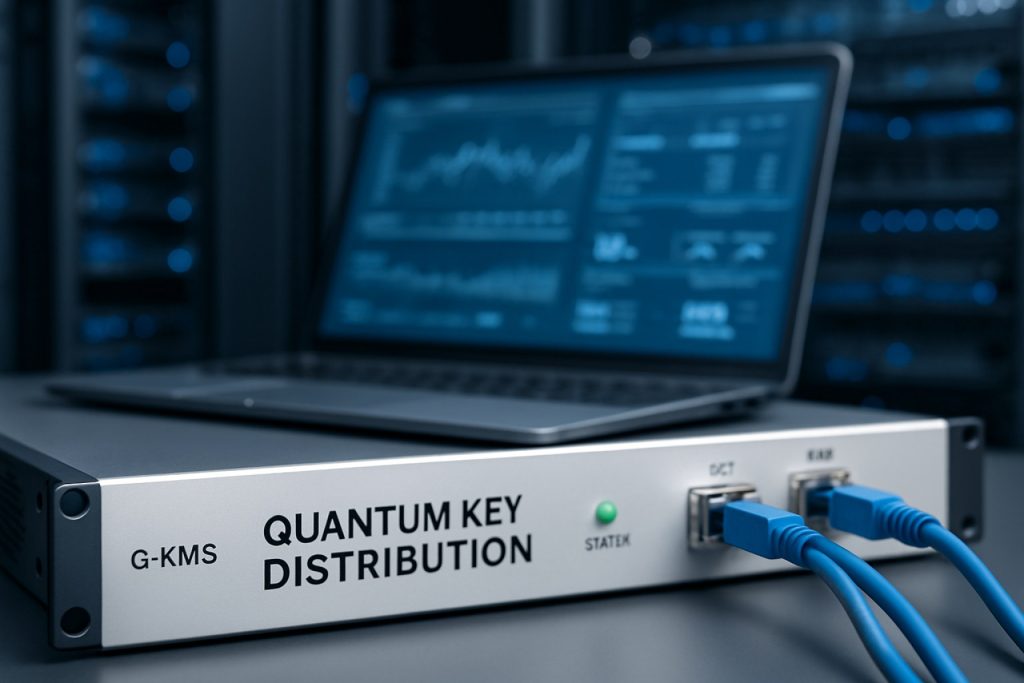
Quantum Key Management Systems Market Report 2025: In-Depth Analysis of Growth Drivers, Technology Innovations, and Global Opportunities. Explore Market Size, Competitive Dynamics, and Future Trends Shaping the Industry.
- Executive Summary & Market Overview
- Key Technology Trends in Quantum Key Management Systems
- Competitive Landscape and Leading Vendors
- Market Growth Forecasts and Revenue Projections (2025–2030)
- Regional Market Analysis: North America, Europe, Asia-Pacific, and Rest of World
- Future Outlook: Emerging Applications and Investment Hotspots
- Challenges, Risks, and Strategic Opportunities
- Sources & References
Executive Summary & Market Overview
Quantum Key Management Systems (QKMS) represent a transformative advancement in the field of cybersecurity, leveraging the principles of quantum mechanics to generate, distribute, and manage cryptographic keys with unprecedented security. As of 2025, the QKMS market is experiencing accelerated growth, driven by escalating concerns over quantum computing’s potential to compromise classical encryption methods and the increasing adoption of quantum-safe security solutions across critical sectors.
The global QKMS market is projected to reach a valuation of approximately USD 1.2 billion by 2025, expanding at a compound annual growth rate (CAGR) of over 30% from 2022 to 2025, according to MarketsandMarkets. This surge is fueled by heightened investments in quantum communication infrastructure, government-led cybersecurity initiatives, and the integration of QKMS into financial services, defense, and healthcare industries.
Key market drivers include the proliferation of quantum computing research, the emergence of quantum networks, and regulatory mandates for post-quantum cryptography. Notably, regions such as North America, Europe, and East Asia are at the forefront, with significant deployments and pilot projects led by organizations like IBM, Toshiba, and ID Quantique. These companies are pioneering QKMS solutions that enable secure key exchange over both fiber-optic and free-space channels, addressing the vulnerabilities of traditional key management systems.
The competitive landscape is characterized by strategic partnerships between technology vendors, telecom operators, and research institutions. For instance, BT Group and Toshiba have collaborated on quantum-secure communication networks in the UK, while China Quantum Communication Co., Ltd. is advancing large-scale QKMS deployments in Asia.
Despite robust growth prospects, the QKMS market faces challenges such as high implementation costs, interoperability issues, and the need for standardized protocols. However, ongoing R&D and international standardization efforts, led by bodies like the International Telecommunication Union (ITU), are expected to mitigate these barriers and foster broader adoption.
In summary, 2025 marks a pivotal year for Quantum Key Management Systems, with the market poised for rapid expansion as organizations worldwide seek to future-proof their cryptographic infrastructure against the looming threat of quantum-enabled cyberattacks.
Key Technology Trends in Quantum Key Management Systems
Quantum Key Management Systems (QKMS) are rapidly evolving to address the emerging security challenges posed by quantum computing. As organizations prepare for a post-quantum cryptography era, several key technology trends are shaping the QKMS landscape in 2025.
- Integration with Quantum Key Distribution (QKD): QKMS are increasingly being designed to seamlessly integrate with QKD networks, enabling the secure generation and distribution of cryptographic keys using quantum mechanics principles. This integration is crucial for achieving end-to-end quantum-safe communication, as demonstrated by pilot projects in Europe and Asia (ID Quantique).
- Hybrid Cryptographic Approaches: To ensure backward compatibility and gradual migration, QKMS are adopting hybrid models that combine quantum-resistant algorithms with classical encryption. This dual-layered approach allows organizations to maintain security during the transition period, as recommended by the National Institute of Standards and Technology (NIST).
- Cloud-Based Quantum Key Management: Major cloud service providers are introducing QKMS solutions as part of their security portfolios, offering scalable and flexible key management for enterprises. These cloud-based systems facilitate rapid deployment and integration with existing IT infrastructure (Google Cloud, Amazon Web Services).
- Interoperability and Standardization: The push for interoperability between different QKMS vendors and QKD devices is intensifying. Industry consortia and standards bodies are working on protocols and APIs to ensure seamless communication and key exchange across heterogeneous networks (ETSI).
- Enhanced Automation and Orchestration: Automation is becoming central to QKMS, with advanced orchestration tools enabling real-time key lifecycle management, policy enforcement, and threat detection. This reduces human error and improves response times to potential quantum threats (Gartner).
These trends reflect a broader industry shift towards quantum-resilient security architectures, with QKMS at the core of future-proofing sensitive data and communications against quantum-enabled attacks.
Competitive Landscape and Leading Vendors
The competitive landscape for Quantum Key Management Systems (QKMS) in 2025 is characterized by a mix of established cybersecurity vendors, quantum technology specialists, and emerging startups, all vying for leadership in a rapidly evolving market. The growing threat of quantum computing to classical encryption methods has accelerated investment and innovation in QKMS, with vendors focusing on interoperability, scalability, and integration with existing IT infrastructure.
Leading vendors in the QKMS space include:
- ID Quantique: A pioneer in quantum-safe cryptography, ID Quantique offers end-to-end QKMS solutions, including quantum random number generators and quantum key distribution (QKD) systems. The company’s Cerberis platform is widely adopted in financial services and government sectors.
- Toshiba Digital Solutions: Leveraging decades of research, Toshiba provides QKMS integrated with its QKD hardware, targeting telecom operators and critical infrastructure providers. Its solutions emphasize high-speed key generation and seamless integration with classical networks.
- QuantumCTek: As a leading Chinese quantum technology company, QuantumCTek supplies QKMS and QKD products for large-scale deployments, including national quantum communication networks in China.
- SecureRF: Specializing in quantum-resistant cryptography, SecureRF offers key management solutions designed for IoT and edge devices, focusing on lightweight protocols suitable for constrained environments.
- ETSI: While not a vendor, the European Telecommunications Standards Institute (ETSI) plays a pivotal role in shaping interoperability standards for QKMS, influencing vendor strategies and product development.
Startups such as Kuano and Qrypt are also gaining traction, offering software-based QKMS that leverage quantum entropy sources and post-quantum cryptography. Strategic partnerships between telecom operators, cloud service providers, and quantum hardware vendors are becoming increasingly common, as seen in collaborations like BT and Toshiba’s quantum-secure network trials in the UK.
Overall, the QKMS market in 2025 is marked by rapid technological advancement, a strong emphasis on standards compliance, and a dynamic mix of global and regional players. Vendors are differentiating through integration capabilities, performance, and future-proofing against quantum threats, with market consolidation expected as the technology matures and adoption accelerates.
Market Growth Forecasts and Revenue Projections (2025–2030)
The market for Quantum Key Management Systems (QKMS) is poised for significant expansion in 2025, driven by escalating concerns over quantum computing threats to classical encryption and the increasing adoption of quantum-safe security solutions across critical sectors. According to projections by MarketsandMarkets, the global quantum cryptography market—which includes QKMS as a core segment—is expected to grow from approximately USD 200 million in 2024 to over USD 350 million by the end of 2025, reflecting a compound annual growth rate (CAGR) exceeding 20%.
Key drivers for this growth in 2025 include:
- Government Initiatives: National cybersecurity strategies in the US, EU, and Asia-Pacific are prioritizing quantum-resistant infrastructure, with substantial funding allocated to quantum key distribution (QKD) and QKMS deployment. For instance, the National Institute of Standards and Technology (NIST) is advancing post-quantum cryptography standards, accelerating enterprise adoption of QKMS.
- Telecom and Financial Sector Adoption: Major telecom operators and financial institutions are piloting QKMS to secure backbone networks and sensitive transactions. Deutsche Telekom and BBVA have announced quantum-safe trials, signaling early commercial traction.
- Vendor Ecosystem Expansion: Leading technology vendors such as IBM, Toshiba, and ID Quantique are launching next-generation QKMS platforms, with enhanced interoperability and integration capabilities, further fueling market growth.
Revenue projections for 2025 indicate that North America will remain the largest regional market, accounting for over 40% of global QKMS revenues, followed by Europe and Asia-Pacific. The enterprise segment—particularly in banking, government, and healthcare—will represent the bulk of QKMS spending, as organizations seek to future-proof data confidentiality and regulatory compliance.
Looking ahead, the 2025 market landscape will be characterized by increased pilot deployments, early commercial rollouts, and a growing pipeline of large-scale QKMS projects. This momentum is expected to set the stage for accelerated revenue growth and broader adoption in subsequent years, as quantum computing capabilities continue to advance and regulatory pressures intensify.
Regional Market Analysis: North America, Europe, Asia-Pacific, and Rest of World
The global market for Quantum Key Management Systems (QKMS) is poised for significant growth in 2025, driven by escalating cybersecurity threats and the increasing adoption of quantum-safe encryption across various industries. Regional dynamics play a crucial role in shaping the trajectory of QKMS adoption, with North America, Europe, Asia-Pacific, and the Rest of the World (RoW) exhibiting distinct trends and growth drivers.
- North America: North America is expected to maintain its leadership in the QKMS market in 2025, underpinned by robust investments in quantum research, a mature cybersecurity ecosystem, and proactive government initiatives. The United States, in particular, benefits from strong federal funding and the presence of major technology firms such as IBM and Microsoft, both of which are advancing quantum-safe solutions. The region’s financial services, defense, and healthcare sectors are early adopters, seeking to future-proof sensitive data against quantum-enabled attacks. According to IDC, North America will account for the largest share of QKMS spending in 2025, driven by regulatory compliance and the need for advanced cryptographic infrastructure.
- Europe: Europe is rapidly catching up, propelled by the European Union’s Quantum Flagship program and stringent data protection regulations such as GDPR. Countries like Germany, France, and the UK are investing heavily in quantum communication networks and pilot projects. The European market is characterized by strong collaboration between academia, government, and industry, with organizations like Thales Group and ID Quantique leading QKMS deployments. Gartner forecasts robust double-digit growth for the region in 2025, as enterprises seek to align with evolving security standards.
- Asia-Pacific: The Asia-Pacific region is emerging as a dynamic QKMS market, led by China, Japan, and South Korea. China’s government-backed quantum initiatives and the rollout of quantum communication infrastructure are accelerating adoption. Companies such as Baidu and NTT Communications are investing in quantum key distribution and management solutions. According to Frost & Sullivan, Asia-Pacific will witness the fastest QKMS market growth in 2025, fueled by digital transformation and national security imperatives.
- Rest of World (RoW): While adoption in Latin America, the Middle East, and Africa remains nascent, there is growing interest in QKMS as part of broader digital security strategies. Multinational collaborations and pilot projects are expected to lay the groundwork for future market expansion, with support from organizations like the International Telecommunication Union (ITU).
In summary, 2025 will see North America and Europe consolidating their positions as QKMS market leaders, while Asia-Pacific emerges as a high-growth region and RoW begins to explore quantum-safe security solutions.
Future Outlook: Emerging Applications and Investment Hotspots
Quantum Key Management Systems (QKMS) are poised to become a cornerstone of next-generation cybersecurity infrastructure as quantum computing advances threaten traditional cryptographic methods. Looking ahead to 2025, the future outlook for QKMS is shaped by both emerging applications and evolving investment hotspots, driven by the urgent need for quantum-safe security solutions across critical sectors.
Emerging applications for QKMS are rapidly expanding beyond government and defense, which have historically been early adopters. Financial services, healthcare, and telecommunications are now at the forefront of QKMS deployment, seeking to secure sensitive data and communications against quantum-enabled attacks. For instance, major banks and stock exchanges are piloting QKMS to protect transaction data and customer information, anticipating regulatory mandates for quantum-resilient encryption. Similarly, healthcare organizations are exploring QKMS to safeguard patient records and comply with evolving privacy standards, while telecom operators are integrating QKMS into their backbone networks to future-proof data transmission and authentication protocols.
Investment hotspots in 2025 are expected to concentrate in regions with robust quantum research ecosystems and proactive regulatory frameworks. North America, particularly the United States and Canada, continues to attract significant venture capital and government funding for QKMS startups and infrastructure projects, supported by initiatives such as the National Science Foundation’s quantum research programs and the U.S. Department of Energy’s quantum network pilots. In Europe, the European Commission’s Quantum Flagship program and national investments in Germany, the Netherlands, and the UK are accelerating QKMS commercialization and cross-border quantum communication pilots. Meanwhile, China’s aggressive push in quantum technology, led by entities like Chinese Academy of Sciences, is fostering a competitive landscape in Asia-Pacific, with significant state-backed funding for QKMS research and deployment.
Looking forward, the convergence of QKMS with cloud computing, Internet of Things (IoT), and 5G/6G networks is expected to unlock new market opportunities. Strategic partnerships between quantum hardware vendors, cybersecurity firms, and telecom operators are likely to accelerate the integration of QKMS into mainstream digital infrastructure. As a result, analysts project a surge in both public and private investment, with the global QKMS market expected to grow at a double-digit CAGR through 2030, according to International Data Corporation (IDC) and Gartner forecasts.
Challenges, Risks, and Strategic Opportunities
Quantum Key Management Systems (QKMS) are emerging as a critical component in the transition to quantum-safe cryptography, but their adoption in 2025 faces a complex landscape of challenges, risks, and strategic opportunities. The primary challenge lies in interoperability with existing classical infrastructure. Most enterprise networks and public key infrastructures (PKIs) are not natively designed to support quantum-generated keys, necessitating significant upgrades or hybrid solutions that can bridge classical and quantum systems. This integration complexity can slow deployment and increase costs, especially for large organizations with legacy systems.
Another significant risk is the evolving threat landscape. While QKMS are designed to counteract the potential of quantum computers to break classical encryption, the technology itself is still maturing. There is uncertainty regarding the timeline for practical quantum attacks, which complicates investment decisions for organizations weighing the urgency of quantum-safe upgrades. Additionally, the lack of universally accepted standards for QKMS—despite ongoing efforts by bodies such as the European Telecommunications Standards Institute (ETSI) and the National Institute of Standards and Technology (NIST)—creates fragmentation and potential vendor lock-in risks.
Security risks also persist within QKMS implementations. Quantum key distribution (QKD) protocols, a core component of many QKMS, are theoretically secure but can be vulnerable to side-channel attacks, implementation flaws, or physical tampering. Ensuring end-to-end security requires rigorous certification and continuous monitoring, which can be resource-intensive. Moreover, the high cost and specialized hardware requirements of QKD-based systems limit scalability, particularly for organizations with distributed or global operations.
Despite these challenges, strategic opportunities abound. Early adopters in sectors such as finance, government, and critical infrastructure can leverage QKMS to differentiate themselves by offering quantum-resilient security, potentially gaining a competitive edge as regulatory requirements evolve. Partnerships between technology vendors, telecom operators, and research institutions—such as those seen in the BT and Toshiba quantum networks—are accelerating innovation and pilot deployments. Furthermore, as standardization efforts mature and costs decline, QKMS could become a foundational element of next-generation secure communications, opening new markets and business models for solution providers.
Sources & References
- MarketsandMarkets
- IBM
- Toshiba
- ID Quantique
- BT Group
- International Telecommunication Union (ITU)
- National Institute of Standards and Technology (NIST)
- Google Cloud
- Amazon Web Services
- Qrypt
- National Institute of Standards and Technology (NIST)
- BBVA
- Microsoft
- IDC
- Thales Group
- Frost & Sullivan
- National Science Foundation
- European Commission
- Chinese Academy of Sciences



